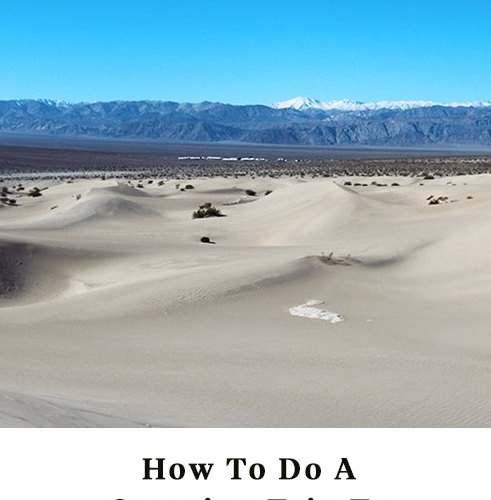
Stipulated: the perfect travel time for a three-day weekend getaway is four hours. More, and you waste your vacation. Less, and you’re still near home. Hence our series, The 4hr. Rule, dedicated to revealing the best destinations that are far away, yet still close to home.
Nothing lasts forever.
Which is why you should go to Death Valley, like, right now.
The wildflowers are in bloom and the heat will start to veer into unbearable territory around mid-March. The stark contrasts of the volcanic rock, sweeping sand dunes and snow-capped mountains make Death Valley one of the truly remarkable SoCal road trips.
It’s desolate, quiet and strangely beautiful — a great place to watch the change of seasons and put your thinking hat on.
MEALS
For cooking, you can’t beat a Dutch oven and a cast-iron skillet. Both disperse heat equally. Prep the following before you go, and place in zip-lock bags:
Dinner: Jambalaya
Onion, green pepper, celery, garlic, bay leaf, table spoon of peanut oil, salt and pepper. Add to your dutch oven when you get there with one cup of rice, one can of tomatoes, any protein of your choice (sausage, diced chicken, kidney beans) and 2.5 cups of water. Cover and let sit on the fire for one hour.
Breakfast: Scramble
Add to one zip-lock bag: diced shallots, potatoes, red pepper, paprika, olive oil, salt and pepper. Place in either the skillet or the dutch oven and cover for 30 minutes, stirring occasionally. Once the potatoes are cooked, add either eggs or tofu. Cook until ready.
Lunch: Sandwiches
Bring sandwiches of your choice for lunches. There isn’t much in the way of decent cuisine between Los Angeles and Death Valley, so something pre-made will be a godsend after those taxing desert hikes.
CAMPING
Texas Springs offers the quietest campsite in Death Valley, and it’s very close to the Furnace Creek General Store, which has ample, cheap firewood and any supplies you may have forgotten. The campsite is separated into two sections, or loops. The first is for tents only, and fills up quickly. The second is for both tents and campers. Both have bathrooms that happen to be very clean.
CANYON HIKING
Badwater Basin (the lowest point in the U.S.) and Artist’s Palette are obligatory, but the canyon hikes are the real hidden gems.
Sidewinder Canyon is a five-mile hike with beautiful rock formations and a small cavern at its conclusion.
Mosaic Canyon is a four-mile route not far from the Mesquite Sand Dunes. The canyon walls are slightly softer and rounder than those in Sidewinder, and there’s a natural amphitheater at the end.
Telescope Peak is for the hardcore backpackers. At 12 miles, it goes to the top of Death Valley, 11,000 feet above sea level, which is a stark contrast to the Badwater, which is 282 feet below sea level. You can camp at the entrance to the trail, but you’ll need a backcountry fire permit.
MEQUITE SAND DUNES
You can’t go to Death Valley and skip the sand dunes. They’re 14 square miles of steep, sandy dales that provide panoramic views of the valley and a brilliant contrast with the various rocks, wildflowers and mesquite wood all around.
The Packing List:
Essential French Oven
Lodge Cast Iron Skillet
Mountain Hardwear Shifter 4P Tent
Amo Coffee Maker
Renegade Active Hydration Pack
Danner Jag Boot
This article was featured in the InsideHook LA newsletter. Sign up now for more from the Southland.